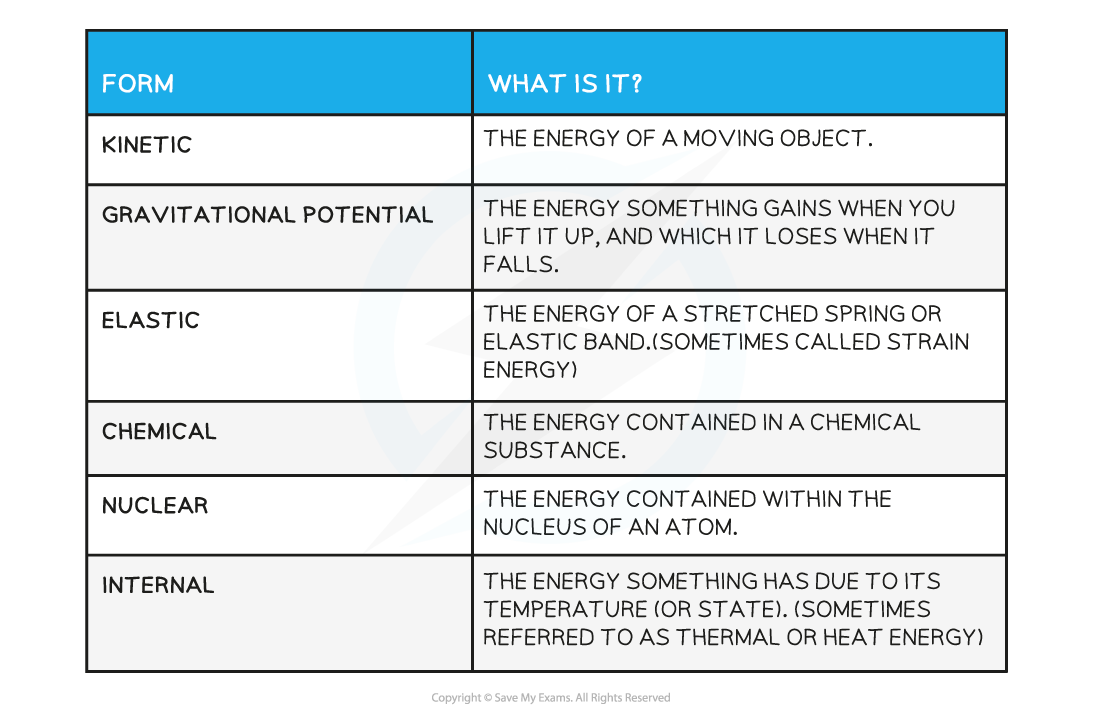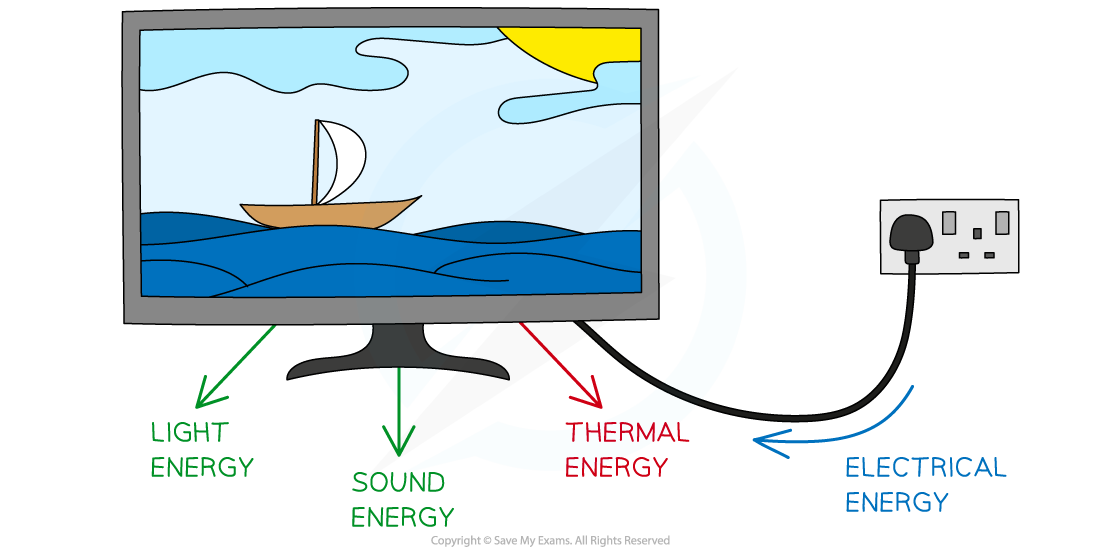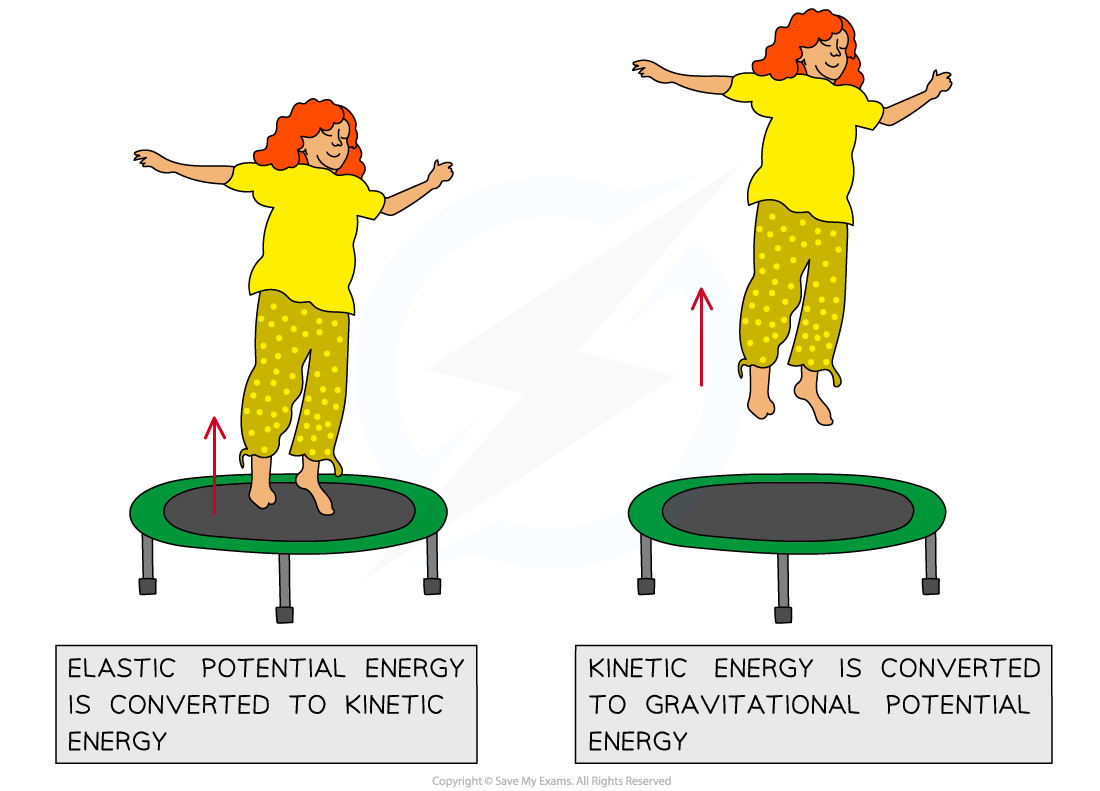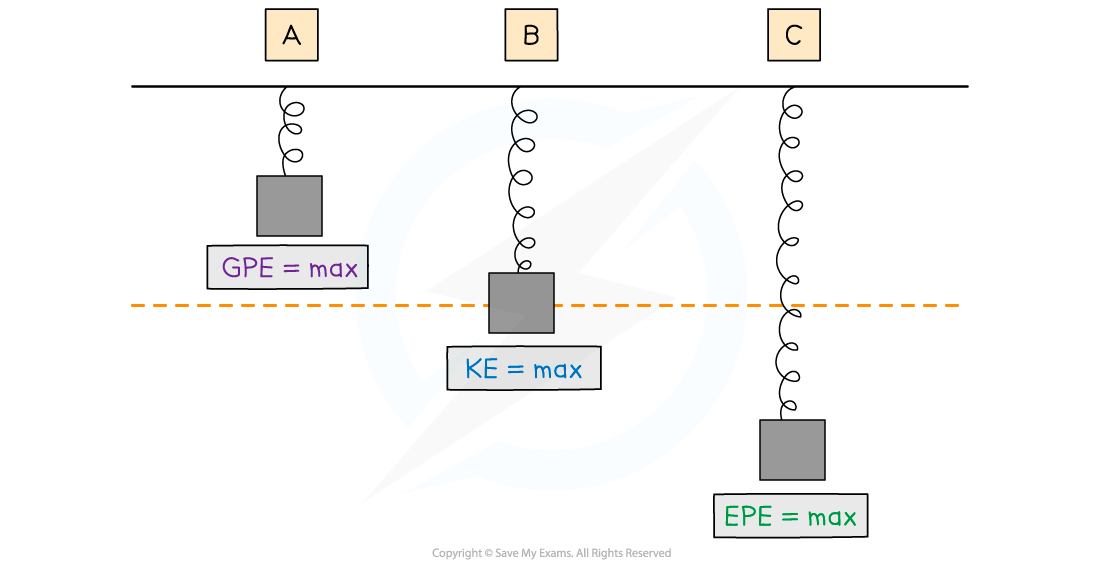Principle of Conservation of Energy
- The Principle of Conservation of Energy states that:
Energy cannot be created or destroyed, it can only be transferred from one form to another
- This means the total amount of energy in a closed system remains constant, although how much of each form there is may change
Types of Energy

Energy types can be separated into transfers or stores
- The differences between energy stores and energy transfers can be confusing, so it is important to learn their differences and the different types of energy involved in each
Energy Stores
- Energy stores keep or store energy within one part of a system
- Kinetic energy store: the amount of energy in a kinetic energy store depends on the speed of the object
- A runner with a high kinetic energy store in her muscles can run more quickly than a runner with a smaller kinetic energy store
- A car with a high kinetic energy store within the engine can drive more quickly than a car with a smaller kinetic energy store
- A racing car has a higher kinetic energy store than a tractor
- Gravitational potential energy store: the amount of energy stored in an object depending on its height
- The higher an object, the more gravitational potential energy it has
- When a diver stands on a board 5 m high he has more gravitational potential energy than when standing on a board 3 m high
- The higher an object, the more gravitational potential energy it has
- Magnetic energy store: magnets store magnetic energy until a magnetic material is present in its field
- A piece of iron will be moved when it enters a magnetic field
- The magnetic energy store is transferred to the kinetic energy of the iron
- Chemical energy store: energy is stored as chemical energy and a chemical reaction takes place to release and then transfer it
- Chemical energy is stored in our body for use when we think and move
- Chemical energy is stored in a battery to be transferred to electrical energy
- Thermal energy store: all objects store thermal energy
- An object that is hotter stores more thermal energy than an object that is colder
- Nuclear energy store: in a nuclear reactor, energy is stored as Uranium-235 until it is bombarded by neutrons and a huge amount of thermal energy is released
Energy Transfers
- Energy transfers: give or transfer energy to different parts of a system
- They act as a pathway around an energy system
- Electrical transfer: when charge flows to produce an electric current
- The current transfers the energy
- Mechanical transfer: this occurs when a force is applied to move an object
- This could be pushing a book across a desk
- It could also be sound waves passing through a material causing the particles to move
- Heating transfer: The internal energy of an object is determined by the temperature of the object
- Energy is transferred from hotter to cooler areas
- Waves transfer: When sound travels through a material it causes the particles to vibrate
- Energy is transferred from an object that is moving/vibrating to generate the sound waves through other objects by the movement of particles
- Light energy is transferred from the sun so we can see
- Electrical transfer: when charge flows to produce an electric current
Energy Dissipation
- When energy is transferred from one form to another, not all the energy will end up in the desired form (or place)
- Dissipation is used to describe ways in which energy is wasted
- Any energy not transferred to useful energy stores is wasted because it is lost to the surroundings
- These are commonly in the form of thermal (heat), light, or sound energy
- What counts as wasted energy depends on the system
- For example, in a television:
electrical energy ➝ light energy + sound energy + thermal energy
- Light and sound energy are useful energy transfers whereas thermal energy (from the heating up of wires) is wasted

Useful and wasted energy conversions for a television
- The energy changes in an electrical heater:
electrical energy ➝ thermal energy + sound energy + light energy
- In a gas cooker, the energy transfers are similar but the initial source of energy is different:
chemical energy ➝ thermal energy + sound energy + light energy
- In both these cases, thermal energy is useful, whereas sound and light are not

Useful and wasted energy conversions in an electric heater and gas cooker
Worked Example
The diagram shows a rollercoaster going down a track.
The rollercoaster takes the path A → B → C → D.

Which statement is true about the energy changes that occur for the rollercoaster down this track?
A. KE - GPE - GPE - KE
B. KE - GPE - KE - GPE
C. GPE - KE - KE - GPE
D. GPE - KE - GPE - KE
ANSWER: D
- At point A:
- The rollercoaster is raised above the ground, therefore it has GPE
- As it travels down the track, GPE is converted to KE and the roller coaster speeds up
- At point B:
- KE is converted to GPE as the rollercoaster rises up the loop
- At point C:
- This GPE is converted back into KE as the rollercoaster travels back down the loop
- At point D:
- The flat terrain means the rollercoaster only has KE
Applications of Energy Conservation
- In mechanical systems when energy is transferred between stores it is equivalent to the work done:
- A falling object (in a vacuum, where no energy is not dissipated into the surroundings): gravitational potential energy ➝ kinetic energy
- Horizontal mass on a spring: elastic potential energy ➝ kinetic energy
- We can also say energy is transferred between stores and transfers:
- A battery connected to a bulb: chemical energy ➝ electrical energy ➝ light energy (if connected to a bulb)
- A car: chemical energy ➝ mechanical energy ➝ kinetic energy

Energy transfers whilst jumping on a trampoline
- There may also be work done against resistive forces such as friction
- For example, if an object travels up a rough inclined surface, then
Loss in kinetic energy = Gain in gravitational potential energy + Work done against friction
Worked Example
A simple pendulum has a mass of 640 g and a length of 0.7 m. It is pulled out to an angle of 20° from the vertical.The pendulum is released. Assuming negligible air resistance, calculate the maximum speed of the pendulum bob as it passes through the vertical position.


Spring Energy Conservation
- When a vertical spring is extended and contracted, its energy is converted into other forms
- Although the total energy of the spring will remain constant, it will have changing amounts of:
- Elastic potential energy (EPE)
- Kinetic energy (KE)
- Gravitational potential energy (GPE)
- When a vertical mass is hanging on a spring and it moves up and down, its energy will convert between the three in various amounts

- At position A:
- The spring has some EPE since it is slightly compressed
- Its KE is 0 since it is stationary
- Its GPE is at a maximum because the mass is at its highest point
- At position B:
- The spring has some EPE since it is slightly stretched
- Its KE is at a maximum as it passes through the equilibrium position at its maximum speed
- It has some GPE since the mass is still above the ground
- At position C:
- The spring has its maximum EPE because it is at its maximum extension
- Its KE is 0 since it is stationary
- Its GPE is at a minimum because it is at its lowest point above the Earth's surface
- For a horizontal mass on a spring system, there is no gravitational potential energy to consider. The spring only converts between kinetic and elastic potential energy
